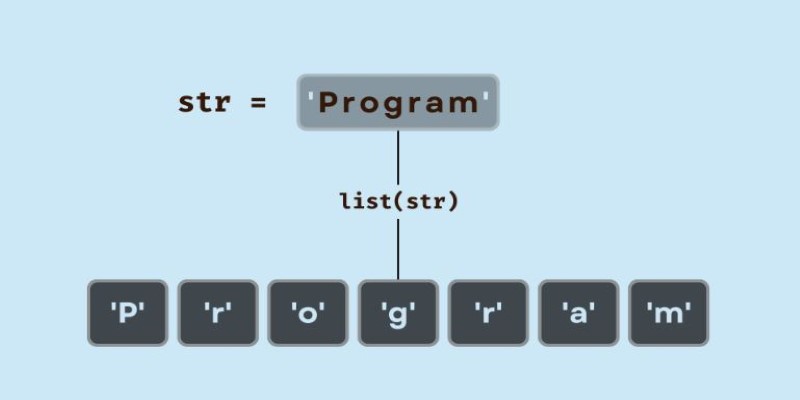Advertisement
If you’re working with text in Python, chances are you’ll need to break a string into smaller parts. That’s where converting a string to a list comes in. It’s one of those common tasks that’s easy to overlook but comes in handy all the time—whether you’re parsing CSV files, splitting user input, or breaking a sentence into words. Python makes this easy with built-in methods and a few clever tricks.
This article walks through different ways to convert a string into a list, each one with a use case in mind. No fluff, no unnecessary jargon—just clean Python code and clear reasoning.
This is probably the most common way people convert strings to lists. If you have a sentence like "apple orange banana", using .split() will break it into a list of words. By default, it splits by whitespace.
python
CopyEdit
text = "apple orange banana"
result = text.split()
print(result)
# Output: ['apple', 'orange', 'banana']
You can also define your separator:
python
CopyEdit
data = "apple,orange,banana"
result = data.split(",")
print(result)
# Output: ['apple', 'orange', 'banana']
This is useful when working with delimited text like CSVs or user inputs.

If your goal is to break a string into individual characters, the list() function is all you need.
python
CopyEdit
word = "hello"
result = list(word)
print(result)
# Output: ['h', 'e', 'l', 'l', 'o']
This works well when you're working with letter-by-letter operations like cipher algorithms or character frequency analysis.
List comprehensions give you more control. It’s like list(), but you can tweak the output or add conditions.
python
CopyEdit
text = "python"
result = [char for char in text]
print(result)
# Output: ['p', 'y', 't', 'h', 'o', 'n']
You can also use it for filtering:
python
CopyEdit
text = "python3.11"
result = [char for char in text if char.isalpha()]
print(result)
# Output: ['p', 'y', 't', 'h', 'o', 'n']
This approach is better when you want a filtered or processed version of the string.
Python’s re module (regular expressions) allows more advanced splitting. Suppose you have a string like "cat1dog2bird3" and want to split at every digit:
python
CopyEdit
import re
text = "cat1dog2bird3"
result = re.split(r'\d+', text)
print(result)
# Output: ['cat', 'dog', 'bird', '']
re.split() can handle patterns that str.split() can't. You can match multiple delimiters or even ranges.
python
CopyEdit
text = "apple;orange,banana|grape"
result = re.split(r'[;,|]', text)
print(result)
# Output: ['apple', 'orange', 'banana', 'grape']
Sometimes a string looks like a list, but it’s just a string: '["red", "blue", "green"]'. Don’t use eval()—it’s unsafe. Use ast.literal_eval() instead.
python
CopyEdit
import ast
text = '["red", "blue", "green"]'
result = ast.literal_eval(text)
print(result)
# Output: ['red', 'blue', 'green']
This is useful when reading data from files or APIs that return list-like strings.
If the string comes from a JSON file or API, json.loads() can turn it into a list. For example:
python
CopyEdit
import json
text = '["sun", "moon", "stars"]'
result = json.loads(text)
print(result)
# Output: ['sun', 'moon', 'stars']
Unlike ast.literal_eval(), json.loads() only works with valid JSON. It won’t parse single quotes or Python-specific types.
Sometimes your string has numbers you want to convert into a list of integers:
python
CopyEdit
data = "1 2 3 4 5"
result = list(map(int, data.split()))
print(result)
# Output: [1, 2, 3, 4, 5]
This pattern is often used in coding problems where input comes in as a space-separated string of numbers. You can also use float, str.strip, or custom functions inside map().

The csv module is made for parsing comma-separated values properly. If your string is a row of CSV data, this method handles quoted strings and embedded commas better than split().
python
CopyEdit
import csv
from io import StringIO
text = 'apple,"orange,cut",banana'
f = StringIO(text)
reader = csv.reader(f)
result = list(reader)[0]
print(result)
# Output: ['apple', 'orange,cut', 'banana']
This is the go-to method if you're parsing lines from a CSV file or stream. It handles edge cases cleanly.
If you need to split a string into three parts—before a separator, the separator itself, and after the separator—partition() is a clean option. It returns a tuple, but you can easily convert that into a list.
python
CopyEdit
text = "username:password"
result = list(text.partition(":"))
print(result)
# Output: ['username', ':', 'password']
This is especially useful when you’re dealing with structured strings like key-value pairs or configuration lines. If the separator occurs more than once and you only want to split at the last occurrence, use rpartition().
python
CopyEdit
text = "path/to/file.txt"
result = list(text.rpartition("/"))
print(result)
# Output: ['path/to', '/', 'file.txt']
While not as commonly used for general list conversion, partition() gives you precise control over the split point—great for parsing structured inputs where format matters.
Python gives you several clean ways to turn strings into lists, each suited for a different type of input. Some methods are best for simple word splits, while others handle structured formats like JSON, CSV, or character-level data. The choice depends on what your string looks like and what you need from the result. Whether you’re breaking down sentences, extracting numbers, or parsing data from files, Python has a direct solution. By understanding how each method behaves, you can pick the right tool without extra workarounds. The process isn’t hard—it’s just about matching the method to the structure of the text you're working with.
Advertisement

Explore the core technology behind ChatGPT and similar LLMs, including training methods and how they generate text.

How to handle NZEC (Non-Zero Exit Code) errors in Python with be-ginner-friendly steps and clear examples. Solve common runtime issues with ease

Discover machine learning model limitations driven by data demands. Explore data challenges and high-quality training data needs

How to translate your audio using Rask AI to create multilingual voiceovers and subtitles with ease. Discover how this AI tool helps globalize your content fast

What if you could measure LLM accuracy without endless manual checks? Explore how LangChain automates evaluation to keep large language models in check

Discover how machine learning is shaping the future with smarter tools, personalized tech, and new opportunities for innovation

Find out the 8 top-rated AI tools for social media growth that can help you boost engagement, save time, and simplify content creation. Learn how these AI-powered social media tools can transform your strategy

Alluxio debuts a new orchestration layer designed to speed up data access and workflows for AI and ML workloads.

Looking for a better way to organize your email inbox? Clean Email helps you sort, filter, and declutter with smart automation and privacy-first tools

Discover how ChatGPT can help Dungeon Masters and players enhance their Dungeons and Dragons experience by generating NPCs, plot hooks, combat encounters, and world lore

Think ChatGPT is always helping you study? Learn why overusing it can quietly damage your learning, writing, and credibility as a student.

Looking for a reliable AI essay writer in 2025? Explore the top 10 tools that help generate, structure, and polish essays—perfect for students and professionals